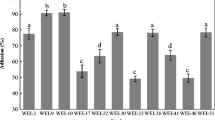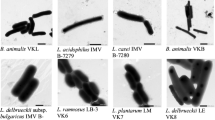Abstract
Estimation of bile tolerance, endurance to gastric and intestinal environment and adhesion potential to intestinal cells are significant selection criteria for probiotic lactic acid bacteria (LAB). In this paper, the probiotic potential of native bacteriocin-producing LAB isolated previously from indigenous source has been determined through quantitative approaches. Among fifteen anti-listerial bacteriocin-producing native LAB, ten strains were found to be bile tolerant. The presence of bile salt hydrolase (bsh) gene in native Lactobacillus plantarum strains was detected by PCR and confirmed by nucleic acid sequencing of a representative amplicon. Interestingly, three native LAB strains exhibited significant viability in simulated gastric fluid, analogous to the standard LAB Lactobacillus rhamnosus GG, while an overwhelming majority of the native LAB strains demonstrated the ability to survive and remain viable in simulated intestinal fluid. Quantitative adhesion assays based on conventional plating method and a fluorescence-based method revealed that the LAB isolates obtained from dried fish displayed significant in vitro adhesion potential to human adenocarcinoma HT-29 cells, and the adhesion level was comparable to some of the standard probiotic LAB strains. The present study unravels putative probiotic attributes in certain bacteriocin-producing LAB strains of non-human origin, which on further in vivo characterization could find specific applications in probiotic food formulations targeted for health benefits.



Similar content being viewed by others
References
Coolbear T, Crow V, Harnett J, Harvey S, Holland R, Martley F (2008) Developments in cheese microbiology in New Zealand—Use of starter and non-starter lactic acid bacteria and their enzymes in determining flavour. Int Dairy J 18:705–713
Leroy F, De Vuyst L (2004) Lactic acid bacteria as functional starter cultures for the food fermentation industry. Trends Food Sci Technol 15:67–78
Jagannath A, Ramesh A, Ramesh MN, Chandrashekar A, Varadaraj MC (2001) Predictive model for the behavior of Listeria monocytogenes Scott A in Shrikhand, prepared with a biopreservative pediocin K7. Food Microbiol 18:335–343
Jones RJ, Hussein HM, Zagorec M, Brightwell G, Tagg JR (2008) Isolation of lactic acid bacteria with inhibitory activity against pathogens and spoilage organisms associated with fresh meat. Food Microbiol 25:228–234
Singh AK, Ramesh A (2008) Succession of dominant and antagonistic lactic acid bacteria in fermented cucumber: insights from a PCR-based approach. Food Microbiol 25:278–287
Singh AK, Mukherjee S, Adhikari MD, Ramesh A (2012) Fluorescence-based comparative evaluation of bactericidal potency and food application potential of anti-listerial bacteriocin produced by lactic acid bacteria isolated from indigenous samples. Probiotics Antimicrob Proteins 4:122–132
Lebeer S, Vanderleyden J, De Keersmaecker SC (2008) Genes and molecules of lactobacilli supporting probiotic action. Microbiol Mol Biol Rev 72:728–764
Marco ML, Pavan S, Kleerebezem M (2006) Towards understanding molecular modes of probiotic action. Curr Opin Biotechnol 17:204–210
Ouwehand AC, Seppo Salminen, Isolauri E (2002) Probiotics: an overview of beneficial effects. Antonie Van Leeuwenhoek 82:279–289
Servin AL, Coconnier MH (2003) Adhesion of probiotic strains to the intestinal mucosa and interaction with pathogens. Best Pract Res Clin Gastroenterol 17:741–754
Yan F, Polk DB (2010) Probiotics: progress toward novel therapies for intestinal diseases. Curr Opin Gastroenterol 26:95–101
Alander M, Satokari R, Korpela R, Saxelin M, Vilpponen-Salmela T, Mattila-Sandholm T (1999) Persistence of colonization of human colonic mucosa by a probiotic strain, Lactobacillus rhamnosus GG, after oral consumption. Appl Environ Microbiol 65:351–354
Elliott SN, Buret MW, Miller MJS, Wallace JL (1998) Bacteria rapidly colonize and modulate healing of gastric ulcers in rats. Am J Physiol Gastrointest Liver Physiol 275:425–432
Collado MC, Meriluoto J, Salminen S (2007) Role of commercial probiotic strains against human pathogen adhesion to intestinal mucus. Lett Appl Microbiol 45:454–460
Reid G, Burton J (2002) Use of Lactobacillus to prevent infection by pathogenic bacteria. Microbes Infect 4:319–324
Pagnini C, Saeed R, Bamias G, Aresneau KO, Pizarro TT, Cominelli F (2010) Probiotics promote gut health through stimulation of epithelial innate immunity. Proc Natl Acad Sci 107:454–459
Zhou JS, Gill HS (2005) Immunostimulatory probiotic Lactobacillus rhamnosus HN001 and Bifidobacterium lactis HN019 do not induce pathological inflammation in mouse model of experimental autoimmune thyroiditis. Int J Food Microbiol 103:97–104
Nueno-Palop C, Narbad A (2011) Probiotic assessment of Enterococcus faecalis CP58 isolated from human gut. Int J Food Microbiol 145:390–394
Charteris WP, Kelly PM, Morelli L, Collins JK (1998) Development and application of an in vitro methodology to determine the transit tolerance of potentially probiotic Lactobacillus and Bifidobacterium species in the upper human gastrointestinal tract. J Appl Microbiol 84:759–768
Huang Y, Adams MC (2004) In vitro assessment of the upper gastrointestinal tolerance of potential probiotic dairy propionibacteria. Int J Food Microbiol 91:253–260
Gopal PK, Prasad J, Smart J, Gill HS (2001) In vitro adherence properties of Lactobacillus rhamnosus DR20 and Bifidobactirium lactis DR10 strains and their antagonistic activity against an enterotoxigenic Escherichia coli. Int J Food Microbiol 67:207–216
Sambuy Y, De Angelis I, Ranaldi G, Scarino ML, Stammati A, Zucco F (2005) The Caco-2 cell line as a model of the intestinal barrier: influence of cell and culture-related factors on Caco-2 cell functional characteristics. Cell Biol Toxicol 21:1–26
Tuomola EM, Salminen SJ (1998) Adhesion of some probiotic and dairy Lactobacillus strains to Caco-2 cell cultures. Int J Food Microbiol 5:45–51
Forestier C, De Champs C, Vatoux C, Joly B (2001) Probiotic activities of Lactobacillus casei rhamnosus: in vitro adherence to intestinal cells and antimicrobial properties. Res Microbiol 152:167–173
Binachi MA, Del Rio D, Pellegrini N, Sansebastiano G, Neviani E, Brighenti F (2004) A fluorescence-based method for the detection of adhesive properties of lactic acid bacteria to Caco-2 cells. Lett Appl Microbiol 39:301–305
Blay GL, Fliss I, Lacroix C (2004) Comparative detection of bacterial adhesion to Caco-2 cells with ELISA, radioactivity and plate count method. J Microbiol Methods 59:211–221
Lee YK, Ho PS, Low CS, Arvilommi H, Salminen S (2004) Permanent colonization by Lactobacillus casei is hindered by the low rate of cell division in mouse gut. Appl Environ Microbiol 70:670–674
Chang JH, Shim YY, Cha SK, Chee KM (2010) Probiotic characteristics of lactic acid bacteria isolated from kimchi. J Appl Microbiol 109:220–230
Vitali B, Minervini G, Rizzello CG, Spisni E, Maccaferri S, Brigidi P, Gobbetti M, Di Cagno R (2012) Novel probiotic candidates for humans isolated from raw fruits and vegetables. Food Microbiol 31:116–125
Singh AK, Ramesh A (2009) Evaluation of a facile method of template DNA preparation for PCR-based detection and typing of lactic acid bacteria. Food Microbiol 26:513–540
Jacobsen CN, Rosenfeldt NV, Hayford AE, Møller PL, Michaelsen KF, Paerregaard A, Sandstrom B, Tvede M, Jakobsen M (1999) Screening of probiotic activities of forty-seven strains of Lactobacillus spp. by in vitro techniques and evaluation of the colonization ability of five selected strains in humans. Appl Environ Microbiol 65:4949–4956
Ohland CL, MacNaughton WK (2010) Probiotic bacteria and intestinal epithelial barrier function. Am J Physiol Gastrointest Liver Physiol 298:807–810
Begley M, Gahan CGM, Hill C (2005) The interaction between bacteria and bile. FEMS Microbiol Rev 29:625–651
Chateau N, Deschamps AM, Hadj SA (1994) Heterogeneity of bile salts resistance in the Lactobacillus isolates of a probiotic consortium. Lett Appl Microbiol 18:42–44
Burns P, Vinderola G, Binetti A, Quiberoni A, de los Reyes-Gavilan C, Reinheimer J (2008) Bile-resistant derivatives obtained from non-intestinal dairy lactobacilli. Int Dairy J 18:377–385
Grill JP, Cayuela C, Antoine JM, Schneider F (2000) Isolation and characterization of a Lactobacillus amylovorus mutant depleted in conjugated bile salt hydrolase activity: relation between activity and bile salt resistance. J Appl Microbiol 89:553–563
Kaushik JK, Kumar A, Duary RK, Mohanty AK, Grover S, Batish VK (2009) Functional and probiotic attributes of an indigenous isolate of Lactobacillus plantarum. PLoS ONE 4:1–11
Lambert JM, Bongers RS, de Vos WM, Kleerebezem M (2008) Functional analysis of four bile salt hydrolase and penicillin acylase family members in Lactobacillus plantarum WCFS1. Appl Environ Microbiol 74:4719–4726
Jones BV, Begley M, Hill C, Gahan CGM, Marchesi JR (2008) Functional and comparative metagenomic analysis of bile salt hydrolase activity in the human gut microbiome. Proc Natl Acad Sci 105:13580–13585
McAuliffe O, Cano RJ, Klaenhammer TR (2005) Genetic analysis of two bile salt hydrolase activities in Lactobacillus acidophilus NCFM. Appl Environ Microbiol 71:4925–4929
Patel AK, Singhania RR, Pandey A, Chincholkar SB (2010) Probiotic bile salt hydrolase: current developments and perspectives. Appl Biochem Biotechnol 162:166–180
Liong MT, Shah NP (2005) Acid and bile tolerance and cholesterol removal ability of lactobacilli strains. J Dairy Sci 88:55–66
Blum S, Haller D, Pfeifer A, Schiffrin EJ (2002) Probiotics and immune response. Clin Rev Allergy Immunol 22:287–309
Langerholc T, Maragkoudakis PA, Wollgast J, Gradisnik L, Cencic A (2011) Novel and established cell line models—An indispensable tool in food science and nutrition. Trends Food Sci Technol 22:S11–S20
Ossowski I, Reunanen J, Satokari R, Vesterlund S, Kankainen M, Huhtinen H, Tynkkynen S, Salminen S, De Vos WM, Palva A (2010) Mucosal adhesion properties of the probiotic Lactobacillus rhamnosus GG SpaCBA and SpaFED pilin subunits. Appl Environ Microbiol 76:2049–2057
Jensen H, Grimmer S, Naterstad K, Axelsson L (2012) In vitro testing of commercial and potential probiotic lactic acid bacteria. Int J Food Microbiol 153:216–222
Tallon R, Arias S, Bressollier P, Urdaci MC (2007) Strain- and matrix-dependent adhesion of Lactobacillus plantarum is mediated by proteinaceous bacterial compounds. J Appl Microbiol 102:442–451
Archimbaud C, Shankar N, Forestier C, Baghdayan A, Gilmore MS, Charbonne F, Joly B (2002) In vitro adhesive properties and virulence factors of Enterococcus faecalis strains. Res Microbiol 153:75–80
Hoefel D, Groobya WL, Monisa PT, Andrews S, Saint CP (2003) A comparative study of carboxyfluorescein diacetate and carboxyfluorescein diacetate succinimidyl ester as indicators of bacterial activity. J Microbiol Methods 52:379–388
Ramiah K, van Reenen CA, Dicks LMT (2008) Surface-bound proteins of Lactobacillus plantarum 423 that contribute to adhesion of Caco-2 cells and their role in competitive exclusion and displacement of Clostridium sporogenes and Enterococcus faecalis. Res Microbiol 159:470–475
Acknowledgments
This work was supported by a research grant from Council of Scientific and Industrial Research (CSIR), New Delhi, Government of India [No. 38(1251)/10/EMR-II]. We thank the National Facility of Automated DNA Sequencing, Department of Biochemistry, Delhi University, South Campus for their support in nucleic acid sequencing.
Conflict of interest
The authors declare that they have no conflict of interest.
Author information
Authors and Affiliations
Corresponding author
Rights and permissions
About this article
Cite this article
Mukherjee, S., Singh, A.K., Adhikari, M.D. et al. Quantitative Appraisal of the Probiotic Attributes and In Vitro Adhesion Potential of Anti-listerial Bacteriocin-producing Lactic Acid Bacteria. Probiotics & Antimicro. Prot. 5, 99–109 (2013). https://doi.org/10.1007/s12602-013-9131-5
Published:
Issue Date:
DOI: https://doi.org/10.1007/s12602-013-9131-5




